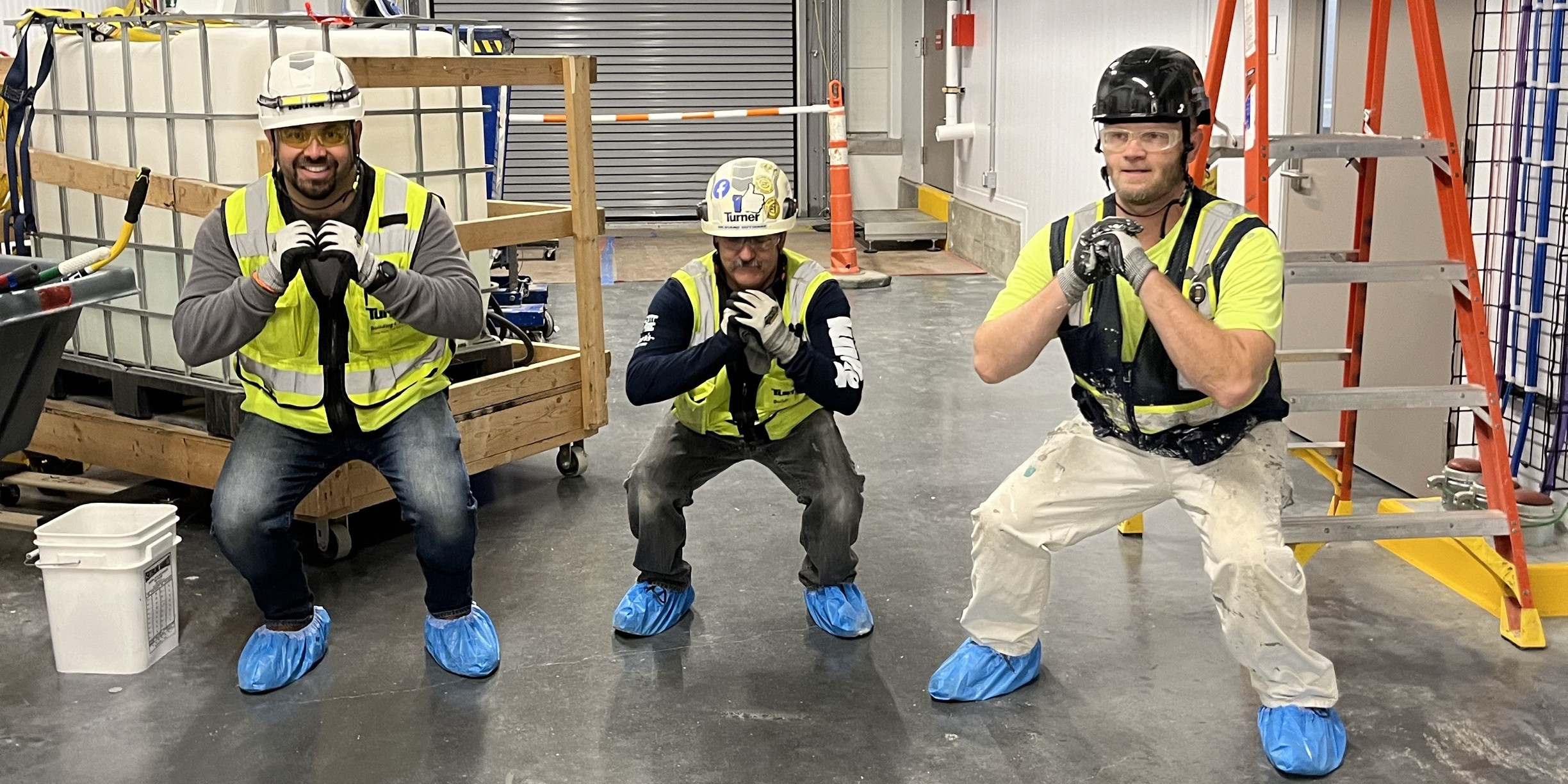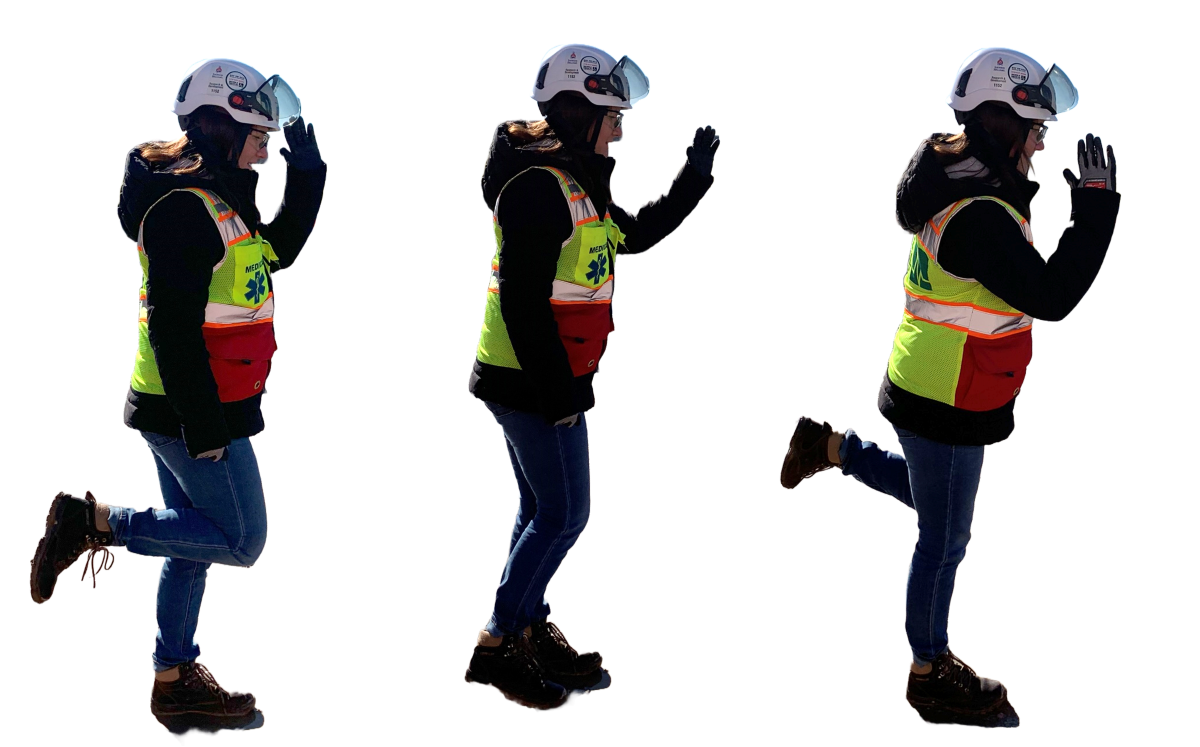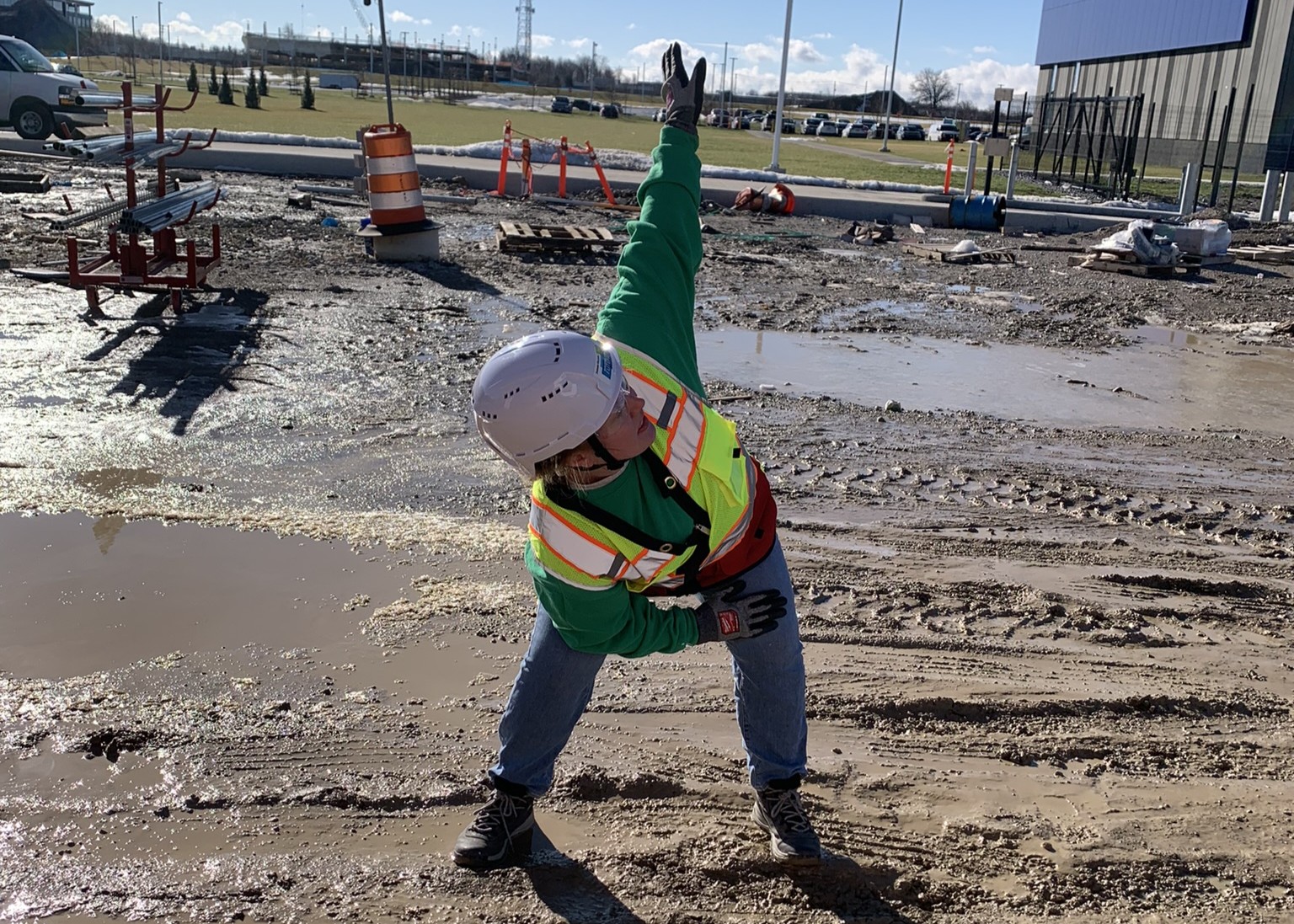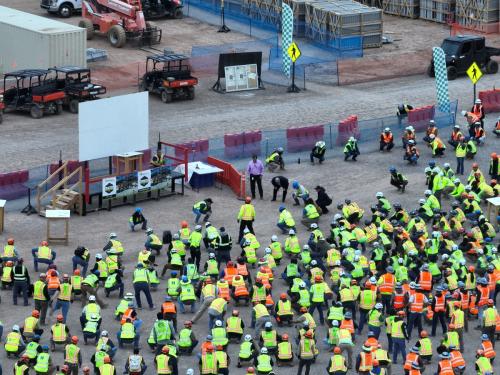Every year, thousands of construction workers are injured on the job, costing companies millions and changing lives in an instant. Musculoskeletal strains and sprains are among the most common injuries, leading to lost workdays, higher insurance premiums, and long-term health problems for employees. But what if there were a simple, proactive way to help prevent many of these injuries before they happen? That's where Stretch and Flex warm-up programs come in!
These structured routines are designed to prepare workers' bodies for the physical demands of construction work. By implementing Stretch and Flex programs, companies can significantly reduce workplace injuries, all while improving employee physical and mental health as well as productivity.
History of Stretch and Flex in Construction

Stretch and Flex first emerged in the manufacturing sector during the 1980s and 1990s, as companies like those in the automotive and aerospace industries sought solutions to a growing problem: repetitive strain injuries among their workers. These early adopters introduced structured warm-up routines to help employees prepare their bodies for physically demanding tasks, and soon saw a reduction in workplace injuries.
As the benefits became clearer, the construction industry began to take notice. Similar to manufacturing, construction work involves repetitive motions and heavy lifting, leading to patterns of musculoskeletal injuries. Companies started adapting Stretch and Flex routines to fit the unique challenges of outdoor, ever-changing job sites.
Today, these programs are widely supported by both industry leaders and regulatory bodies, including the Occupational Safety and Health Administration (OSHA).
The Science Behind Stretch and Flex Programs
Stretch and Flex warm-up programs are rooted in basic principles of human physiology and movement science. When construction workers take a few minutes to stretch cold muscles before starting their tasks, several important changes happen in the body. First, stretching increases blood flow to key muscle groups, which helps warm them up and prepares them for physical activity. This improved circulation delivers more oxygen and nutrients to muscle tissue, making it less likely that workers will experience strains or fatigue early in their shift.
Regular stretching also improves flexibility and range of motion. When muscles and joints are more flexible, they can move freely with less risk of injury. Dynamic stretching further reduces muscle tension and stiffness, both of which are common causes of discomfort.
Stretch and Flex warm-up programs activate proprioceptive awareness, as well; this is the body's ability to sense its position or movement in space. Taking time to stretch as a group will assist construction workers in mentally preparing for the day, increasing focus and awareness of potential hazards.
Benefits of Stretch and Flex Programs
The main objective of a Stretch and Flex program is to improve physical health and to reduce workplace injuries, particularly musculoskeletal disorders that are common in the construction industry. These programs also aim to improve worker flexibility and physical readiness, making daily construction tasks safer and more manageable.
Additionally, Stretch and Flex routines help foster a stronger safety culture and encourage better team communication. Starting the day with a group stretch will help boost morale and job satisfaction among workers.
Benefits for Workers
- Reduced Pain and Discomfort: Regular stretching helps minimize aches and pains, making it easier for workers to get through physically demanding shifts.
- Improved Energy Levels: According to labor statistics, construction workers often report feeling more energized and less fatigued throughout the day after participating in Stretch and Flex routines.
- Better Work-Life Balance: By reducing chronic pain and discomfort, these programs can help workers enjoy a healthier balance between their job and personal life.
- Job Longevity: With fewer injuries and less strain, workers are more likely to have longer, more sustainable careers in the construction industry.
Benefits for Employers
- Lower Workers' Compensation Costs: Fewer injuries mean less money spent on medical claims and workers' compensation.
- Reduced Absenteeism and Turnover: A healthier workforce leads to fewer sick days and less employee turnover, helping construction companies maintain a stable team.
- Improved Productivity and Work Quality: Workers who have better physical fitness are more productive and can deliver higher-quality work.
- Company Safety Reputation: A visible commitment to worker health, safety, and wellness programs can improve a company's reputation, making it more attractive to clients as well as potential construction professionals and employees.
Stretch and Flex Implementation Strategy

A successful Stretch and Flex program doesn't happen by accident; it requires a structured, phased approach. Here's how to implement a program that truly makes a difference on your construction sites!
Phase 1: Planning and Buy-in
The foundation of any effective Stretch and Flex initiative is strong support from management. Securing leadership buy-in not only helps with budget allocation but also sets the tone for company-wide participation.
Start by assembling a cross-functional implementation team that includes safety managers, supervisors, and frontline workers. This team will champion the program and ensure it addresses real-world needs.
Next, conduct a thorough analysis of baseline injury data. Understanding your current rates of strains, sprains, and musculoskeletal injuries will help you identify problem areas and set realistic, measurable goals. Define clear success metrics (such as reduced injury rates, improved worker participation, or increased flexibility scores) to track progress and demonstrate value.
Phase 2: Safety Program Design
With your groundwork laid, move on to designing a program tailored to your workforce. Assess the specific job tasks and injury risks present in your operations. For construction, this might mean focusing on back, shoulder, and leg stretches that address common movements like lifting, carrying, or overhead work.
Customize the exercise routines to fit these needs, making certain they're practical and easy to perform on-site. Develop a schedule that works with your crews' routines, whether that's a 10-minute session at the start of each shift or before particularly strenuous tasks. Decide on locations (i.e., break areas, near tool cribs) and duration to minimize disruption.
Finally, create engaging training materials and resources, such as visual guides, demonstration videos, or quick-reference cards, to help workers learn and remember the routines.
Phase 3: Pilot Program
Before rolling out the program company-wide, start with a pilot on one crew or project site. This allows you to gather valuable feedback from participants/supervisors and to observe how the program fits into daily operations. Track early results, especially participation rates and any immediate feedback on soreness or flexibility.
Use this information to refine your approach; adjust exercises, tweak the schedule, or improve training materials as needed. The pilot phase is your opportunity to iron out any kinks and build a group of advocates for the program!
Phase 4: Full Rollout
Once the pilot has proven successful, it's time to expand. Roll out the Stretch and Flex program to all crews and sites, ensuring every worker has access to the same resources and routines. Train supervisors and crew leaders to lead sessions, establishing them as role models for participation.
It's also important to standardize protocols across the organization for consistency and to integrate the program with your existing safety initiatives. Remember to regularly review injury data and participation metrics to keep the program on track as well as demonstrate its ongoing value.
How to Conduct Effective Stretch and Flex Sessions

A well-structured Stretch and Flex session has a powerful impact on both injury prevention and daily readiness on construction sites. This is how to run an effective session, step by step:
Session Structure (10-15 Minutes)
Opening (2-3 minutes)
- Start with a brief safety reminder or highlight a relevant safety topic for the day.
- Discuss any weather or site-specific hazards that may impact the day's work or warm-up.
- Emphasize the importance of today's session in preventing strains, sprains, and other common injuries.
Dynamic Warm-up (3-4 minutes)
- Lead with repetitive tasks and movements like marching in place, arm circles, or butt kickers to increase heart rate and blood flow.
- Incorporate movements such as shoulder stretches, neck stretches, hip openers, and shoulder rolls.
- Start slow and build up, ensuring everyone is moving within their comfort zone.
Targeted Stretching (5-7 minutes)
- Focus on stretches that target the muscle groups most used in the day's work (i.e., back, upper body, legs).
- Leaders should demonstrate each movement, offering corrections as needed and emphasizing proper stretching techniques.
- Encourage everyone to join in on the warm-up, but remind them to only move to their level of comfort. No pain, just gentle stretching and movement.
Closing (1-2 minutes)
- Encourage workers to mentally prepare for the day's tasks.
- Open the floor for questions or quick team check-ins.
- Thank everyone for participating and reinforcing the value of daily warm-ups.
Key Exercises for Occupational Workers
When selecting Stretch and Flex exercises, aim for 5-10 movements that cover all major body regions: neck, shoulders, shoulder blades, elbows, wrists, trunk, hips, knees, ankles, and hands. Rotate routines every 6 weeks to keep things fresh and effective. A few examples to consider:
|
Head Bobbles |
Stand straight and gently roll your head from side to side, tucking your chin and squeezing your shoulder blades back and down. Repeat 5-10x. |
|
Shoulder Blade Squeeze |
Squeeze shoulder blades back and down, hold for 3-5 seconds, relax. Repeat 3-5x. |
|
Palm Press/Reverse Palm Press |
Alternate pressing palms and backs of hands together, holding each for 3-5 seconds. Repeat 3-5x. |
|
Alternating Shoulder Diagonals |
Raise one arm up and away while pulling the other down in a diagonal motion. Repeat 5-10x each side. |
|
Elbow Flossing |
Extend the arm, apply gentle overpressure, and move the elbow in and out. Repeat 5-10x each side. |
|
Butt Kickers/Walking Butt Kickers |
Kick heels up to glutes, pumping arms. Repeat 5-10x each side. |
|
Hip Openers |
Lift knee, rotate hip out and back, alternate sides. Repeat 5-10x each side. |
|
Heel Raises |
Lift heels off the ground, squeeze calves, and lower slowly. Repeat 10x. |
|
Wood Chops |
Move arms in a diagonal pattern from the hip to the opposite shoulder. Repeat 3-5x each side. |
|
Lateral Stretch |
Reach arm overhead, gently pull, and side bend, hold for 3-5 seconds. Repeat 3-5x each side. |
|
Squats |
Hinge at the hips and knees, lower down, then return to stand. Repeat 3-5x. |
Best Practices for Stretch and Flex

✅Hold Stretch and Flex sessions at the same time and location each day for routine and reliability.
✅Consult with your construction site to determine the ideal session length. The American College of Sports Medicine recommends 5-10 minutes for warm-ups.
✅Focus on dynamic, full-body movements (no static holds longer than 10 seconds) and higher repetitions through full ranges of motion.
✅Sessions should be led by trained supervisors or health professionals who can demonstrate proper form and provide corrections.
✅Always remind participants to move slowly and with control. Modify or scale movements as needed to avoid inflicting any discomfort.
✅ Adjust warm-up routines for hot, cold, or wet conditions to keep everyone safe and comfortable.
✅Use upbeat, work-appropriate music if possible, and keep instructions clear and encouraging.
✅Review participation and injury data. Update routines every month or as needed to keep the program as engaging as possible.
Overcoming Common Challenges in Stretch and Flex Programs
Even the best-designed Stretch and Flex programs can face obstacles on the path to success. Understanding and proactively addressing these common challenges will help ensure your program delivers real results.
Worker Resistance
It's natural for some workers to be skeptical about new routines, especially if they perceive stretching as unnecessary or time-consuming.
Start by sharing the "why" behind the program, highlighting real injury statistics, personal stories, and the benefits of improved flexibility and reduced pain. As participation grows and workers begin to feel the benefits, resistance typically fades.
Time Constraints
On busy job sites, supervisors or crews may worry that Stretch and Flex sessions will cut into productivity. To overcome this, demonstrate the return on investment (ROI): even a 10-minute daily warm-up can significantly reduce lost time due to injuries, improve focus and mental well-being, and boost morale. Proper stretching does not need to take a long periods of time!
Remember to emphasize that a small time investment up front can save hours (or even days) of lost work later!
Seasonal and Weather Issues
Outdoor work means dealing with the elements. Cold, rain, or extreme heat might make outdoor stretching unsafe, so be sure to prepare by developing indoor alternatives and weather-appropriate modifications.
Use break rooms, covered areas, or even large equipment bays for sessions during inclement weather. Adjust routines to include more movement and less static stretching in the cold, or shorten sessions during extreme heat.
Supervisor Buy-in
Supervisors set the tone for participation. If they're not on board, workers are less likely to take the program seriously.
As such, it's very important to invest in supervisor training, emphasizing their leadership role in safety and health. Provide them with the tools and knowledge to confidently lead sessions, answer questions, and model proper technique.
Measuring Stretch and Flex Program Success
Implementing a Stretch and Flex program is a significant investment in your construction worker's health and safety, but how do you know if it's working? Here's how to track both the numbers and the human impact of your new initiatives.
Quantitative Metrics
- Begin by collecting hard data to evaluate the effectiveness of your Stretch and Flex initiative:
- Injury Rates and Severity: Monitor the frequency and severity of musculoskeletal injuries before and after program implementation.
- Workers' Compensation Claims: Track the number of claims related to strains, sprains, and overexertion.
- Absenteeism Rates: Reduced injuries and improved well-being should translate to fewer missed workdays.
- Participation Rates: Consistent participation is a strong indicator of program acceptance and potential impact. Record daily or weekly attendance to spot areas for improvement.
Qualitative Assessments
Numbers are important, but don't overlook the value of direct feedback and cultural shifts:
- Worker Satisfaction Surveys: Ask your team how they feel about the program. Are they experiencing less discomfort? Do they feel more prepared for work?
- Supervisor Feedback: Supervisors can provide valuable insights into morale, engagement, and any operational challenges or successes.
- Safety Culture Improvements: Look for signs of a stronger safety culture, including more proactive behaviors, better teamwork, and increased accountability.
- Overall Health and Wellness Indicators: Pay attention to anecdotal reports of improved energy, fewer aches and pains, and a more positive work environment.
Taking the Next Step: On-Site Medical Services
Once a Stretch and Flex program is established and showing measurable improvements, it may be time to explore additional ways to support workforce health and wellness programs. Introducing on-site medical services is a practical next step for many organizations.
With medical professionals present at the job site, workers have direct access to immediate care in the event of an injury. This setup allows for prompt assessment and treatment, which often leads to faster recovery and less time away from work. On-site clinicians also provide early intervention for minor issues, helping to address discomfort or strain before it develops into a more serious problem.
Beyond injury response, on-site medical teams contribute to ongoing employee wellness by offering health screenings, ergonomic guidance, and education on injury prevention. They monitor trends in reported symptoms and work closely with safety teams to identify areas for improvement.
This integrated approach supports a healthier, more resilient workforce while maintaining the positive momentum created by a successful Stretch and Flex program.
Make Worker Health a Priority with MMC
Your workers are your most valuable asset. At Mobile Medical Corporation (MMC), we believe that holistic health is the foundation of a safer, more productive workforce.
That's why our on-site occupational health solutions go beyond injury prevention, delivering expert physical therapy, mobility programs, and wellness initiatives designed specifically for your industry.
Connect with MMC today to learn how our integrated health solutions can protect your crew and strengthen your business from the ground.



